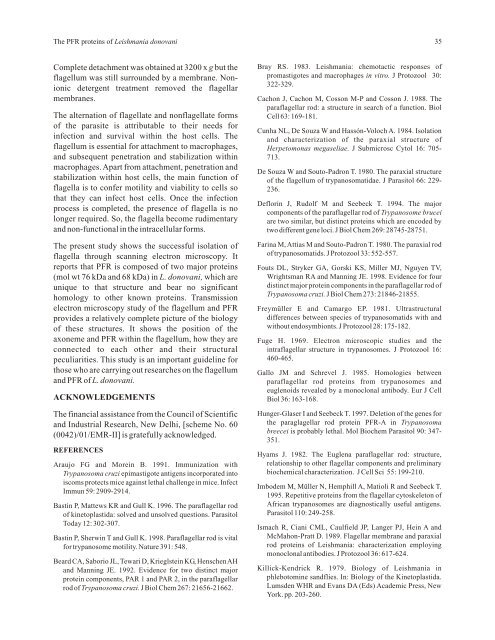PDF File - The Indian Society for Parasitology
PDF File - The Indian Society for Parasitology
PDF File - The Indian Society for Parasitology
Create successful ePaper yourself
Turn your PDF publications into a flip-book with our unique Google optimized e-Paper software.
<strong>The</strong> PFR proteins of Leishmania donovani35Complete detachment was obtained at 3200 x g but theflagellum was still surrounded by a membrane. Nonionicdetergent treatment removed the flagellarmembranes.Bray RS. 1983. Leishmania: chemotactic responses ofpromastigotes and macrophages in vitro. J Protozool 30:322-329.Cachon J, Cachon M, Cosson M-P and Cosson J. 1988. <strong>The</strong>paraflagellar rod: a structure in search of a function. Biol<strong>The</strong> alternation of flagellate and nonflagellate <strong>for</strong>ms Cell 63: 169-181.of the parasite is attributable to their needs <strong>for</strong>Cunha NL, De Souza W and Hassón-Voloch A. 1984. Isolationinfection and survival within the host cells. <strong>The</strong> and characterization of the paraxial structure offlagellum is essential <strong>for</strong> attachment to macrophages, Herpetomonas megaseliae. J Submicrosc Cytol 16: 705-and subsequent penetration and stabilization within 713.macrophages. Apart from attachment, penetration andDe Souza W and Souto-Padron T. 1980. <strong>The</strong> paraxial structurestabilization within host cells, the main function of of the flagellum of trypanosomatidae. J Parasitol 66: 229-flagella is to confer motility and viability to cells so 236.that they can infect host cells. Once the infectionDeflorin J, Rudolf M and Seebeck T. 1994. <strong>The</strong> majorprocess is completed, the presence of flagella is nocomponents of the paraflagellar rod of Trypanosome bruceilonger required. So, the flagella become rudimentary are two similar, but distinct proteins which are encoded byand non-functional in the intracellular <strong>for</strong>ms. two different gene loci. J Biol Chem 269: 28745-28751.<strong>The</strong> present study shows the successful isolation of Farina M, Attias M and Souto-Padron T. 1980. <strong>The</strong> paraxial rodflagella through scanning electron microscopy. It of trypanosomatids. J Protozool 33: 552-557.reports that PFR is composed of two major proteins Fouts DL, Stryker GA, Gorski KS, Miller MJ, Nguyen TV,(mol wt 76 kDa and 68 kDa) in L. donovani, which are Wrightsman RA and Manning JE. 1998. Evidence <strong>for</strong> fourunique to that structure and bear no significant distinct major protein components in the paraflagellar rod ofhomology to other known proteins. TransmissionTrypanosoma cruzi. J Biol Chem 273: 21846-21855.electron microscopy study of the flagellum and PFR Freymüller E and Camargo EP. 1981. Ultrastructuralprovides a relatively complete picture of the biology differences between species of trypanosomatids with andof these structures. It shows the position of the without endosymbionts. J Protozool 28: 175-182.axoneme and PFR within the flagellum, how they are Fuge H. 1969. Electron microscopic studies and theconnected to each other and their structural intraflagellar structure in trypanosomes. J Protozool 16:peculiarities. This study is an important guideline <strong>for</strong> 460-465.those who are carrying out researches on the flagellum Gallo JM and Schrevel J. 1985. Homologies betweenand PFR of L. donovani.paraflagellar rod proteins from trypanosomes andACKNOWLEDGEMENTSeuglenoids revealed by a monoclonal antibody. Eur J CellBiol 36: 163-168.<strong>The</strong> financial assistance from the Council of Scientificand Industrial Research, New Delhi, [scheme No. 60(0042)/01/EMR-II] is gratefully acknowledged.REFERENCESAraujo FG and Morein B. 1991. Immunization withTrypanosoma cruzi epimastigote antigens incorporated intoiscoms protects mice against lethal challenge in mice. InfectImmun 59: 2909-2914.Bastin P, Mattews KR and Gull K. 1996. <strong>The</strong> paraflagellar rodof kinetoplastida: solved and unsolved questions. ParasitolToday 12: 302-307.Bastin P, Sherwin T and Gull K. 1998. Paraflagellar rod is vital<strong>for</strong> trypanosome motility. Nature 391: 548.Beard CA, Saborio JL, Tewari D, Krieglstein KG, Henschen AHand Manning JE. 1992. Evidence <strong>for</strong> two distinct majorprotein components, PAR 1 and PAR 2, in the paraflagellarrod of Trypanosoma cruzi. J Biol Chem 267: 21656-21662.Hunger-Glaser I and Seebeck T. 1997. Deletion of the genes <strong>for</strong>the paraglagellar rod protein PFR-A in Trypanosomabreecei is probably lethal. Mol Biochem Parasitol 90: 347-351.Hyams J. 1982. <strong>The</strong> Euglena paraflagellar rod: structure,relationship to other flagellar components and preliminarybiochemical characterization. J Cell Sci 55: 199-210.Imbodem M, Müller N, Hemphill A, Matioli R and Seebeck T.1995. Repetitive proteins from the flagellar cytoskeleton ofAfrican trypanosomes are diagnostically useful antigens.Parasitol 110: 249-258.Ismach R, Ciani CML, Caulfield JP, Langer PJ, Hein A andMcMahon-Pratt D. 1989. Flagellar membrane and paraxialrod proteins of Leishmania: characterization employingmonoclonal antibodies. J Protozool 36: 617-624.Killick-Kendrick R. 1979. Biology of Leishmania inphlebotomine sandflies. In: Biology of the Kinetoplastida.Lumsden WHR and Evans DA (Eds) Academic Press, NewYork. pp. 203-260.










